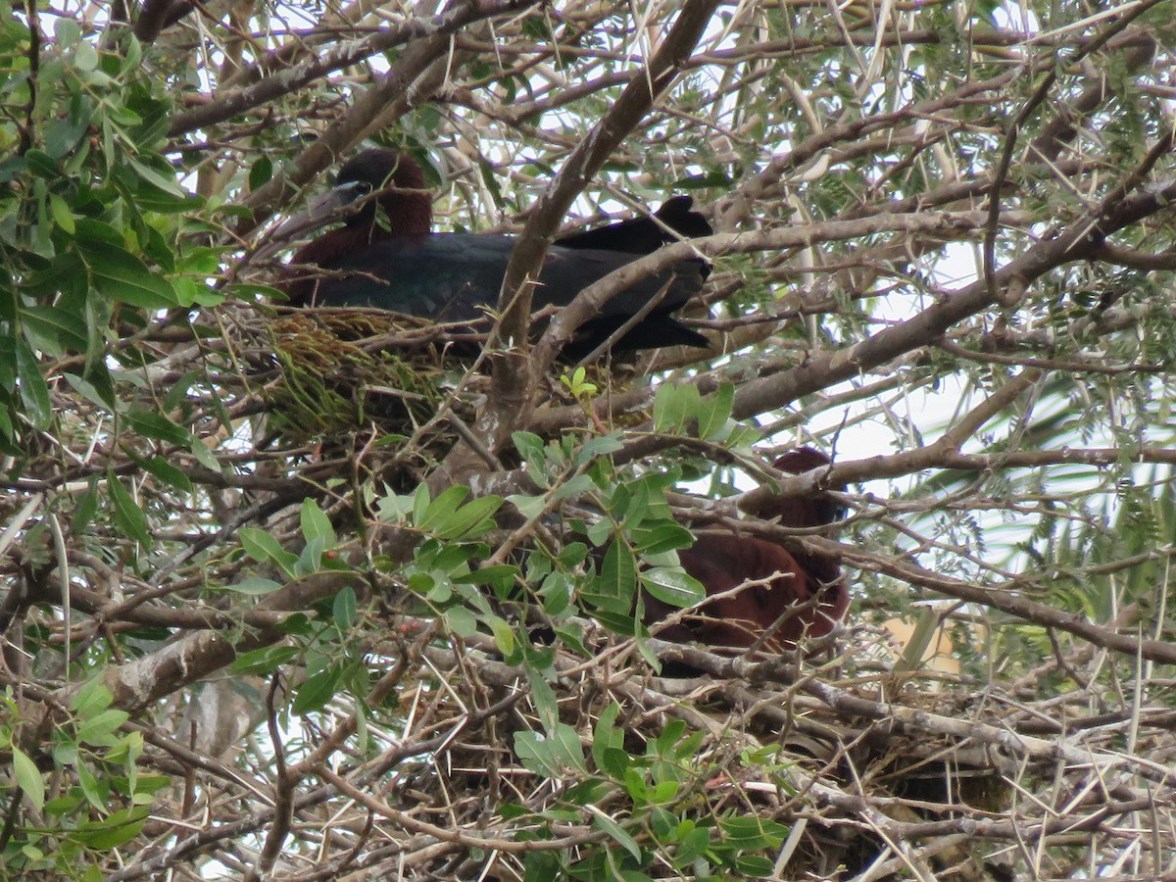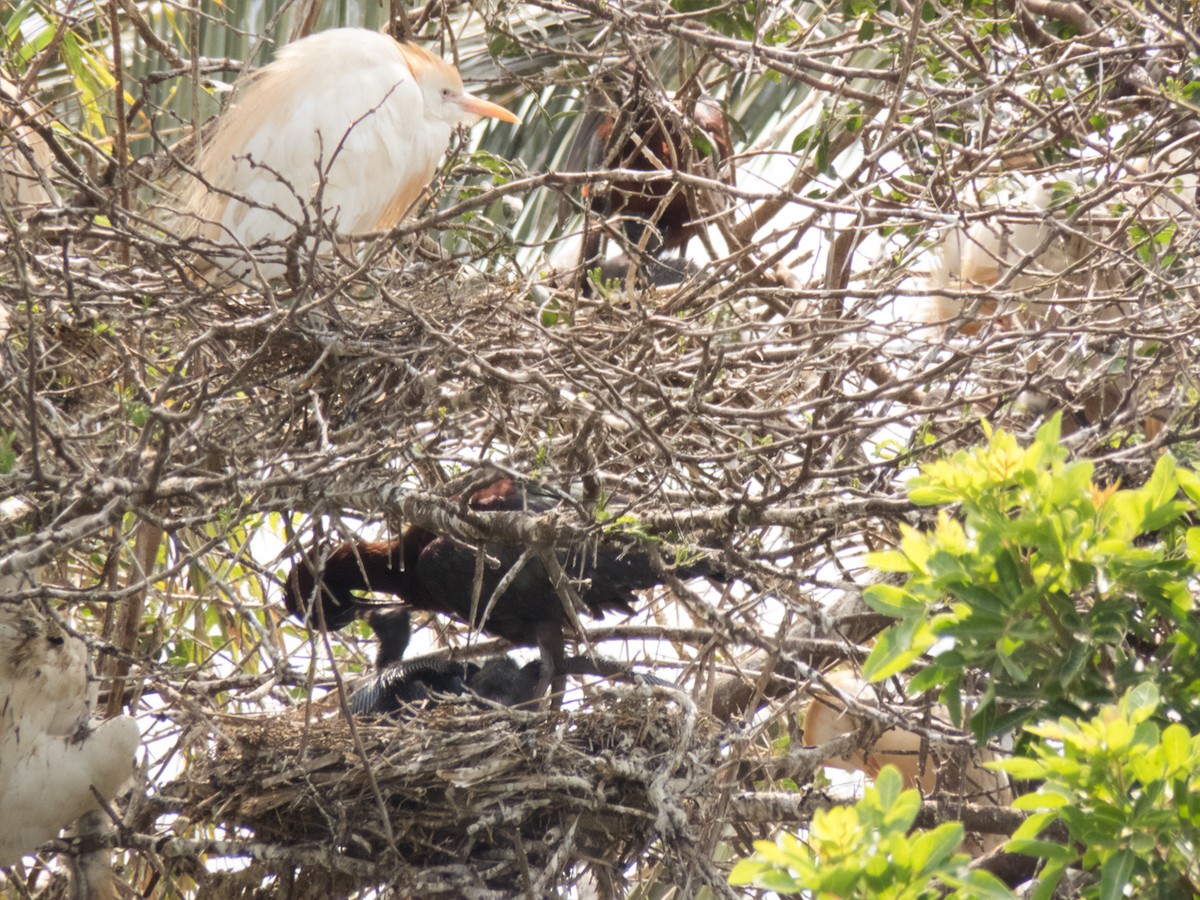The Glossy Ibis (Plegadis falcinellus) continues to expand its breeding areas in Morocco. After the first breeding at Smir heronry near Tétouan in 2011, then at Merja Fouarat near Kénitra in 2013, and at Bouznika and an urban park at Casablanca in 2015, this year it started breeding at Oued Bou Regreg (on the Rabat side of the river).
The new colony was found by the resident birder Pedro Fernandes. Pedro regularly visits the marches of Oued Bou Regreg since the winter months, but started to notice breeding activity on 28 February (birds visiting a probable nest site). He continued to visit the site and on 10 March he observed birds carrying nesting material, and on 17 March he observed occupied nests (photo 1). Since then, he visited the site three times in which he observed small young on the last visit (13 April, photo 2). During this visit, he estimated that more than 50 pairs of Glossy Ibis breed at this colony. Cattle Egret and Black-crowned Night-Heron also breeding there and Little Egret probably do so too.
Here are some emails received from Pedro:
Today [31 March] went back to the Bou Regreg to check the colony, and it is bigger than what I thought it was. The water is drying more and more, so I could gain access to another part of the marshes to look at it— I am not thinking that up to 50 pairs of ibises could be there, but it is hard to have a better number. At one point, in one side of the colony alone I counted 52 birds on the trees, not counting the ones flying or in the marshes. Also found some Night-herons in the colony— including a very fresh flying juvenile, I guess they breed earlier than what I thought. Near the colony was a Squacco Heron, which could either be a breeder or a migrant. Also saw a Purple Heron there, second week in a row— maybe it also breeds there? The Grey Herons I am unsure if they are breeding or not, and the very few Spoonbills I think are not. As a bonus, today saw a Spotted Crake, my first in Morocco. One day on the marshes, talking with a farmer, I asked about ‘muka’ and he told me there were some, but I suspect it is not the marsh kind, as he pointed to trees near the ridge. But who knows? Perhaps there is still a pair or two in the valley.
And:
The colony at Rabat seems larger than what I initially thought, I am now fairly confident that it can have more than 50 pairs.
Went to the marshes one last time yesterday [13 April] to see if the chicks had hatched and they had. Also interesting is the continuing presence of Marbled Teal (the last three visits have been seeing two birds and yesterday just one but it seemed to be displaying) and Ferruginous Ducks. It is always fun to go there and learn a few more things about the birds here— things are like home, but not quite like home (e.g. I thought Grey Herons could be nesting in that colony— they would back in Portugal, but just read that nesting Grey Herons are not a common thing in Morocco). So the learning continues, and as long as it does I am happy and interested.
Obrigado Pedro!


Bonjour,
Lorsque j’étais jeune garçon, dans les années 1976-1979, il y avait un îlot sur le Bou-Regreg, à l’amont du Chellah, je m’y rendais à mobylette et depuis la petite route qui à cet endroit longe le fleuve j’observais dans le bosquet cerné d’eaux une petite colonie de Bihoreaux gris et d’ardéidés divers. Existe-t-elle toujours ? Est-ce la même qu’a découvert Pedro ?
Amitiés ornithologiques
Frédéric
Bonjour Frédéric,
J’ai vérifié et je pense que c’est la même colonie cité dans le ‘Birds of Morocco’, avec l’addition maintenant de l’Ibis falcinelle (sans doute Oued Bou Regreg et les habitats immédiats ont trop changés au cours des années).
hello,
me and my wife do birding! and we just came from the national park ” Sous massa ” and we saw There too many Glossy’s Ibis live in that area right to the river.
Thanks Mohamed! Indeed, Oued Massa was the first site colonised by the Glossy Ibis as a breeding species (Rousseau 1994), but probably did so only for some years. With the breeding expansion of the species to many Moroccan sites, it probably started to breeds there again. But unfortunately few observers visit the right places in the right time to check if the species is breeding or not.
Rousseau, E. 1994. Nouveau cas de reproduction de l’Ibis falcinelle Plegadis falcinellus au Maroc. Alauda 62: 313-314.
Thank you for this post. When I was near the Bypass construction site in early fall 2016, I saw a tagged female Ibis, likely Glossy (maybe you can confirm), in addition to some bee catchers. The photos of two Ibis are at my Twitter account, @cdapelian
Welcome and thank you too for the comment! It’s Glossy Ibis indeed, the other ibis in Morocco is the Northern Glossy Ibis and is different and found mainly in the Souss region (although it can be seen in northern Morocco too, see the links below).
Did you see any behaviour that indicates it’s a female, because the sexes are similar in this species? I think both birds are moulting to winter plumage (less glossy with head and neck mottled with white).
– Migration of the reintroduced Bald Ibises from Spain to Morocco.
– Northern Bald Ibis at Larache, northern Morocco.